CADILLAC STS 2008 1.G Owners Manual
Manufacturer: CADILLAC, Model Year: 2008, Model line: STS, Model: CADILLAC STS 2008 1.GPages: 500, PDF Size: 5.81 MB
Page 481 of 500
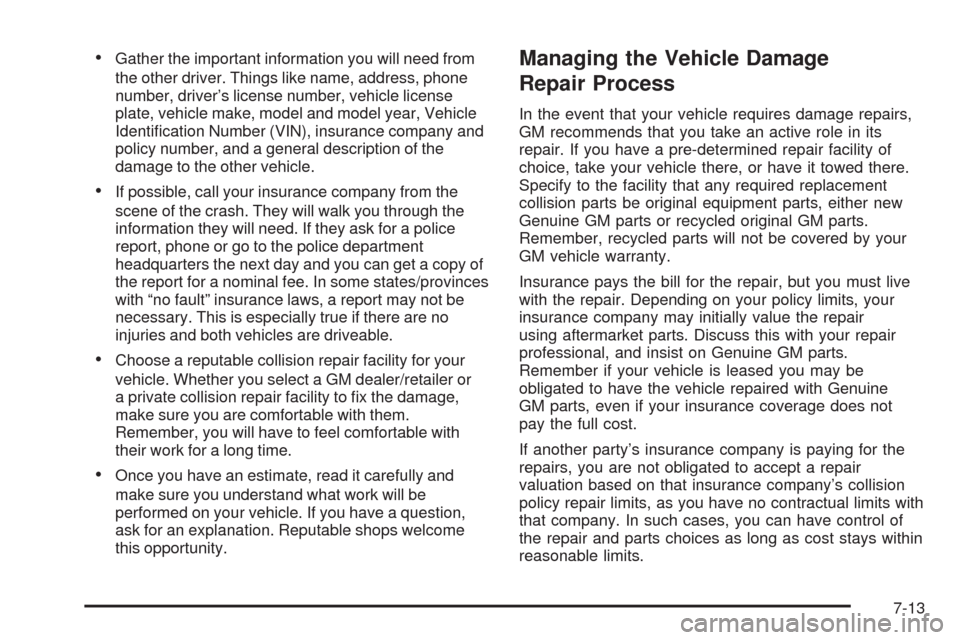
Gather the important information you will need from
the other driver. Things like name, address, phone
number, driver’s license number, vehicle license
plate, vehicle make, model and model year, Vehicle
Identi�cation Number (VIN), insurance company and
policy number, and a general description of the
damage to the other vehicle.
If possible, call your insurance company from the
scene of the crash. They will walk you through the
information they will need. If they ask for a police
report, phone or go to the police department
headquarters the next day and you can get a copy of
the report for a nominal fee. In some states/provinces
with “no fault” insurance laws, a report may not be
necessary. This is especially true if there are no
injuries and both vehicles are driveable.
Choose a reputable collision repair facility for your
vehicle. Whether you select a GM dealer/retailer or
a private collision repair facility to �x the damage,
make sure you are comfortable with them.
Remember, you will have to feel comfortable with
their work for a long time.
Once you have an estimate, read it carefully and
make sure you understand what work will be
performed on your vehicle. If you have a question,
ask for an explanation. Reputable shops welcome
this opportunity.
Managing the Vehicle Damage
Repair Process
In the event that your vehicle requires damage repairs,
GM recommends that you take an active role in its
repair. If you have a pre-determined repair facility of
choice, take your vehicle there, or have it towed there.
Specify to the facility that any required replacement
collision parts be original equipment parts, either new
Genuine GM parts or recycled original GM parts.
Remember, recycled parts will not be covered by your
GM vehicle warranty.
Insurance pays the bill for the repair, but you must live
with the repair. Depending on your policy limits, your
insurance company may initially value the repair
using aftermarket parts. Discuss this with your repair
professional, and insist on Genuine GM parts.
Remember if your vehicle is leased you may be
obligated to have the vehicle repaired with Genuine
GM parts, even if your insurance coverage does not
pay the full cost.
If another party’s insurance company is paying for the
repairs, you are not obligated to accept a repair
valuation based on that insurance company’s collision
policy repair limits, as you have no contractual limits with
that company. In such cases, you can have control of
the repair and parts choices as long as cost stays within
reasonable limits.
7-13
Page 482 of 500
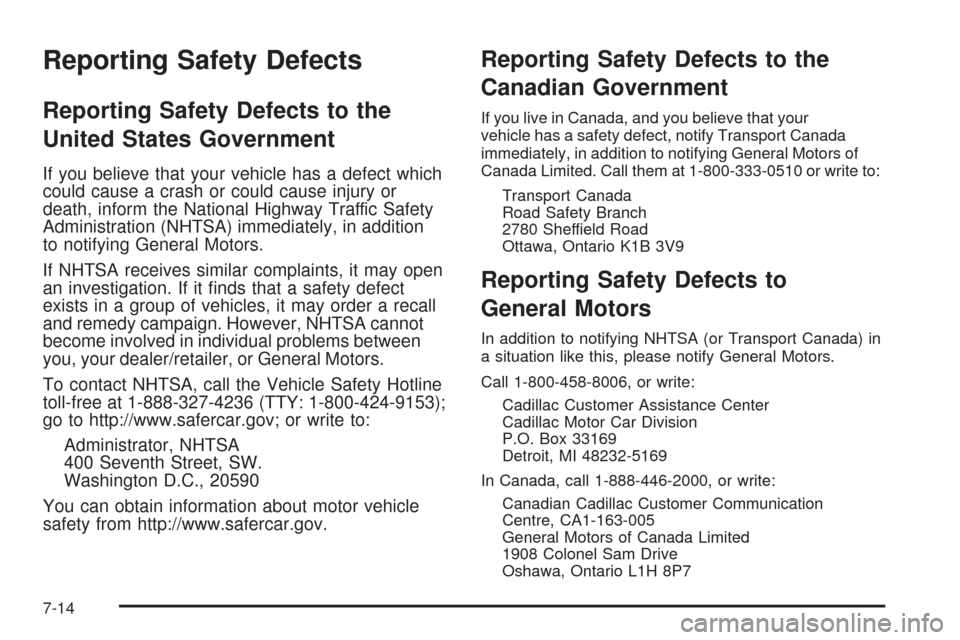
Reporting Safety Defects
Reporting Safety Defects to the
United States Government
If you believe that your vehicle has a defect which
could cause a crash or could cause injury or
death, inform the National Highway Traffic Safety
Administration (NHTSA) immediately, in addition
to notifying General Motors.
If NHTSA receives similar complaints, it may open
an investigation. If it �nds that a safety defect
exists in a group of vehicles, it may order a recall
and remedy campaign. However, NHTSA cannot
become involved in individual problems between
you, your dealer/retailer, or General Motors.
To contact NHTSA, call the Vehicle Safety Hotline
toll-free at 1-888-327-4236 (TTY: 1-800-424-9153);
go to http://www.safercar.gov; or write to:
Administrator, NHTSA
400 Seventh Street, SW.
Washington D.C., 20590
You can obtain information about motor vehicle
safety from http://www.safercar.gov.
Reporting Safety Defects to the
Canadian Government
If you live in Canada, and you believe that your
vehicle has a safety defect, notify Transport Canada
immediately, in addition to notifying General Motors of
Canada Limited. Call them at 1-800-333-0510 or write to:
Transport Canada
Road Safety Branch
2780 Sheffield Road
Ottawa, Ontario K1B 3V9
Reporting Safety Defects to
General Motors
In addition to notifying NHTSA (or Transport Canada) in
a situation like this, please notify General Motors.
Call 1-800-458-8006, or write:
Cadillac Customer Assistance Center
Cadillac Motor Car Division
P.O. Box 33169
Detroit, MI 48232-5169
In Canada, call 1-888-446-2000, or write:
Canadian Cadillac Customer Communication
Centre, CA1-163-005
General Motors of Canada Limited
1908 Colonel Sam Drive
Oshawa, Ontario L1H 8P7
7-14
Page 483 of 500
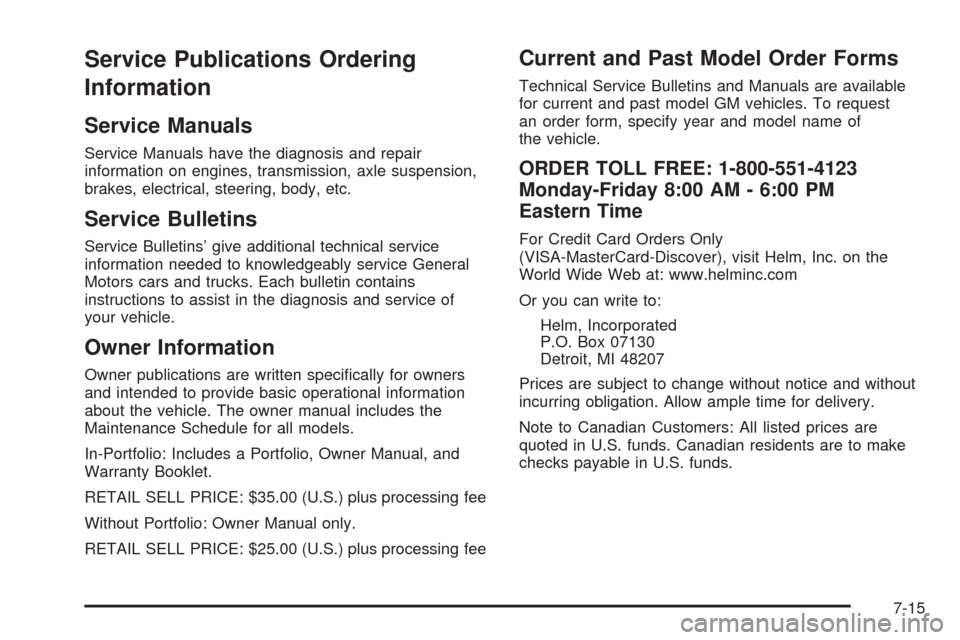
Service Publications Ordering
Information
Service Manuals
Service Manuals have the diagnosis and repair
information on engines, transmission, axle suspension,
brakes, electrical, steering, body, etc.
Service Bulletins
Service Bulletins’ give additional technical service
information needed to knowledgeably service General
Motors cars and trucks. Each bulletin contains
instructions to assist in the diagnosis and service of
your vehicle.
Owner Information
Owner publications are written speci�cally for owners
and intended to provide basic operational information
about the vehicle. The owner manual includes the
Maintenance Schedule for all models.
In-Portfolio: Includes a Portfolio, Owner Manual, and
Warranty Booklet.
RETAIL SELL PRICE: $35.00 (U.S.) plus processing fee
Without Portfolio: Owner Manual only.
RETAIL SELL PRICE: $25.00 (U.S.) plus processing fee
Current and Past Model Order Forms
Technical Service Bulletins and Manuals are available
for current and past model GM vehicles. To request
an order form, specify year and model name of
the vehicle.
ORDER TOLL FREE: 1-800-551-4123
Monday-Friday 8:00 AM - 6:00 PM
Eastern Time
For Credit Card Orders Only
(VISA-MasterCard-Discover), visit Helm, Inc. on the
World Wide Web at: www.helminc.com
Or you can write to:
Helm, Incorporated
P.O. Box 07130
Detroit, MI 48207
Prices are subject to change without notice and without
incurring obligation. Allow ample time for delivery.
Note to Canadian Customers: All listed prices are
quoted in U.S. funds. Canadian residents are to make
checks payable in U.S. funds.
7-15
Page 484 of 500
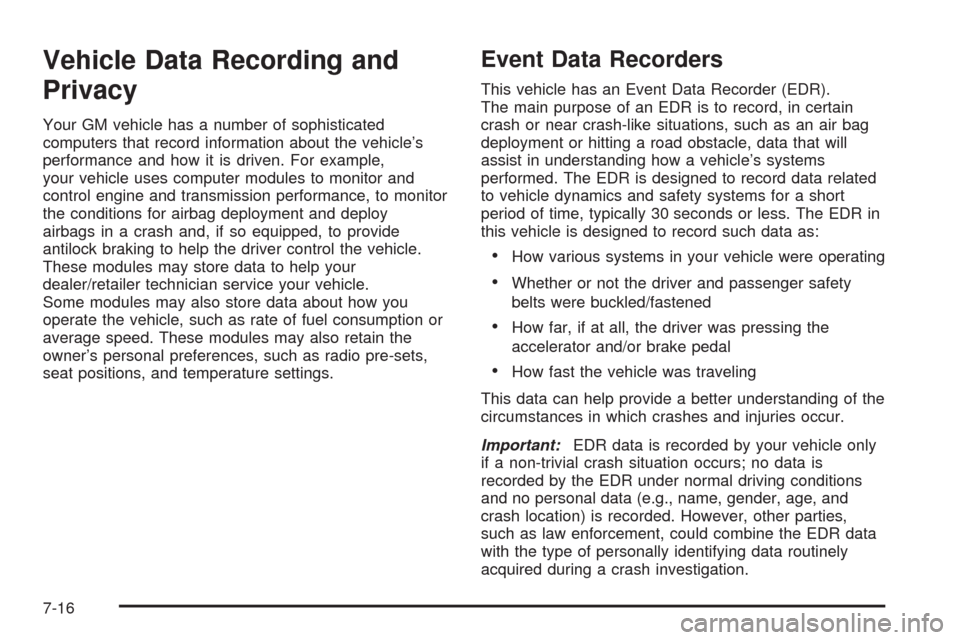
Vehicle Data Recording and
Privacy
Your GM vehicle has a number of sophisticated
computers that record information about the vehicle’s
performance and how it is driven. For example,
your vehicle uses computer modules to monitor and
control engine and transmission performance, to monitor
the conditions for airbag deployment and deploy
airbags in a crash and, if so equipped, to provide
antilock braking to help the driver control the vehicle.
These modules may store data to help your
dealer/retailer technician service your vehicle.
Some modules may also store data about how you
operate the vehicle, such as rate of fuel consumption or
average speed. These modules may also retain the
owner’s personal preferences, such as radio pre-sets,
seat positions, and temperature settings.
Event Data Recorders
This vehicle has an Event Data Recorder (EDR).
The main purpose of an EDR is to record, in certain
crash or near crash-like situations, such as an air bag
deployment or hitting a road obstacle, data that will
assist in understanding how a vehicle’s systems
performed. The EDR is designed to record data related
to vehicle dynamics and safety systems for a short
period of time, typically 30 seconds or less. The EDR in
this vehicle is designed to record such data as:
How various systems in your vehicle were operating
Whether or not the driver and passenger safety
belts were buckled/fastened
How far, if at all, the driver was pressing the
accelerator and/or brake pedal
How fast the vehicle was traveling
This data can help provide a better understanding of the
circumstances in which crashes and injuries occur.
Important:EDR data is recorded by your vehicle only
if a non-trivial crash situation occurs; no data is
recorded by the EDR under normal driving conditions
and no personal data (e.g., name, gender, age, and
crash location) is recorded. However, other parties,
such as law enforcement, could combine the EDR data
with the type of personally identifying data routinely
acquired during a crash investigation.
7-16
Page 485 of 500
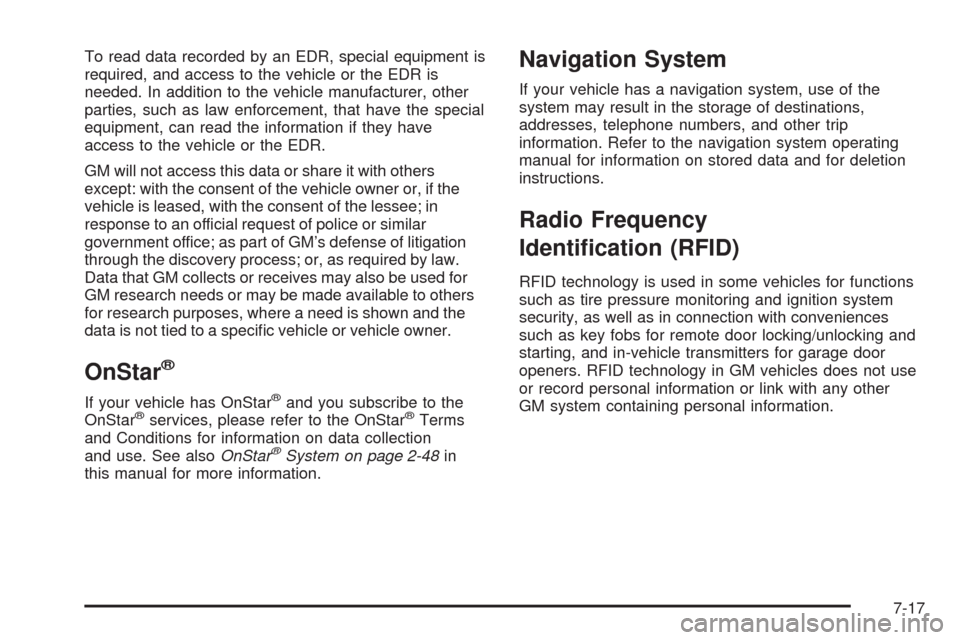
To read data recorded by an EDR, special equipment is
required, and access to the vehicle or the EDR is
needed. In addition to the vehicle manufacturer, other
parties, such as law enforcement, that have the special
equipment, can read the information if they have
access to the vehicle or the EDR.
GM will not access this data or share it with others
except: with the consent of the vehicle owner or, if the
vehicle is leased, with the consent of the lessee; in
response to an official request of police or similar
government office; as part of GM’s defense of litigation
through the discovery process; or, as required by law.
Data that GM collects or receives may also be used for
GM research needs or may be made available to others
for research purposes, where a need is shown and the
data is not tied to a speci�c vehicle or vehicle owner.
OnStar®
If your vehicle has OnStar®and you subscribe to the
OnStar®services, please refer to the OnStar®Terms
and Conditions for information on data collection
and use. See alsoOnStar
®System on page 2-48in
this manual for more information.
Navigation System
If your vehicle has a navigation system, use of the
system may result in the storage of destinations,
addresses, telephone numbers, and other trip
information. Refer to the navigation system operating
manual for information on stored data and for deletion
instructions.
Radio Frequency
Identi�cation (RFID)
RFID technology is used in some vehicles for functions
such as tire pressure monitoring and ignition system
security, as well as in connection with conveniences
such as key fobs for remote door locking/unlocking and
starting, and in-vehicle transmitters for garage door
openers. RFID technology in GM vehicles does not use
or record personal information or link with any other
GM system containing personal information.
7-17
Page 486 of 500
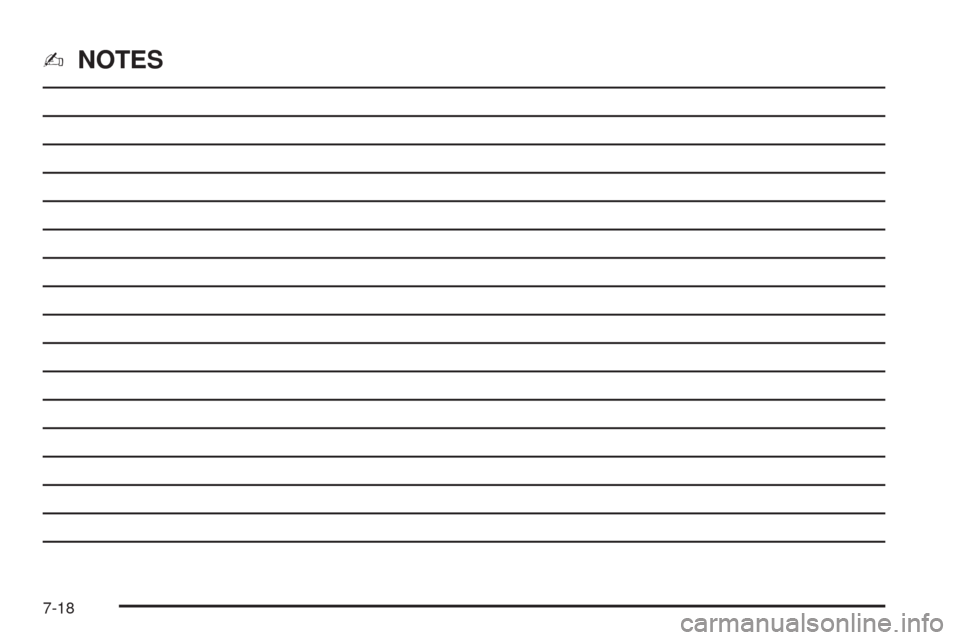
✍NOTES
7-18
Page 487 of 500
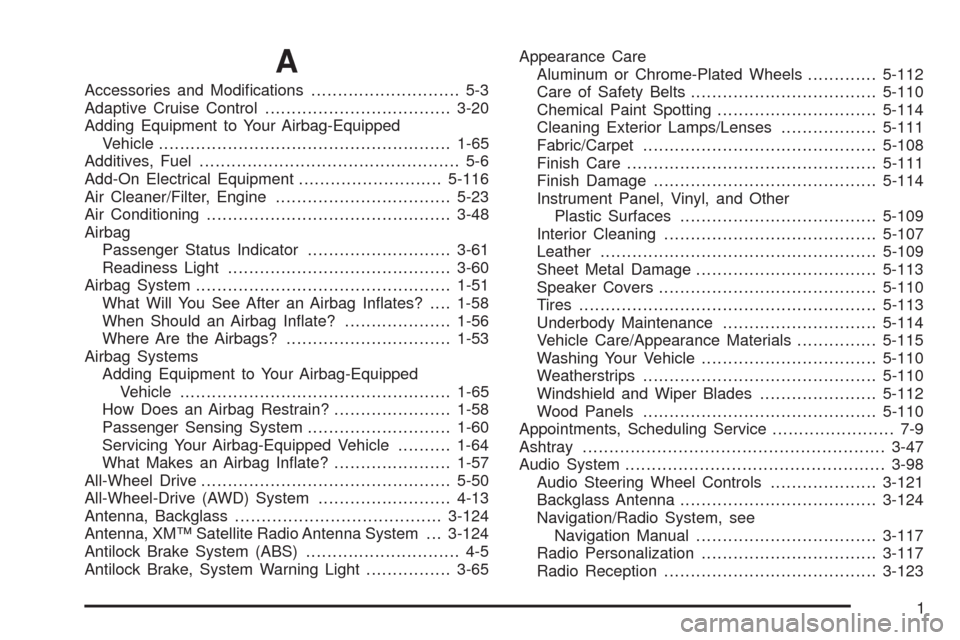
A
Accessories and Modi�cations............................ 5-3
Adaptive Cruise Control...................................3-20
Adding Equipment to Your Airbag-Equipped
Vehicle.......................................................1-65
Additives, Fuel................................................. 5-6
Add-On Electrical Equipment...........................5-116
Air Cleaner/Filter, Engine.................................5-23
Air Conditioning..............................................3-48
Airbag
Passenger Status Indicator...........................3-61
Readiness Light..........................................3-60
Airbag System................................................1-51
What Will You See After an Airbag In�ates?....1-58
When Should an Airbag In�ate?....................1-56
Where Are the Airbags?...............................1-53
Airbag Systems
Adding Equipment to Your Airbag-Equipped
Vehicle...................................................1-65
How Does an Airbag Restrain?......................1-58
Passenger Sensing System...........................1-60
Servicing Your Airbag-Equipped Vehicle..........1-64
What Makes an Airbag In�ate?......................1-57
All-Wheel Drive...............................................5-50
All-Wheel-Drive (AWD) System.........................4-13
Antenna, Backglass.......................................3-124
Antenna, XM™ Satellite Radio Antenna System . . . 3-124
Antilock Brake System (ABS)............................. 4-5
Antilock Brake, System Warning Light................3-65Appearance Care
Aluminum or Chrome-Plated Wheels.............5-112
Care of Safety Belts...................................5-110
Chemical Paint Spotting..............................5-114
Cleaning Exterior Lamps/Lenses..................5-111
Fabric/Carpet............................................5-108
Finish Care...............................................5-111
Finish Damage..........................................5-114
Instrument Panel, Vinyl, and Other
Plastic Surfaces.....................................5-109
Interior Cleaning........................................5-107
Leather....................................................
5-109
Sheet Metal Damage..................................5-113
Speaker Covers.........................................5-110
Tires........................................................5-113
Underbody Maintenance.............................5-114
Vehicle Care/Appearance Materials...............5-115
Washing Your Vehicle.................................5-110
Weatherstrips............................................5-110
Windshield and Wiper Blades......................5-112
Wood Panels............................................5-110
Appointments, Scheduling Service....................... 7-9
Ashtray.........................................................3-47
Audio System.................................................3-98
Audio Steering Wheel Controls....................3-121
Backglass Antenna.....................................3-124
Navigation/Radio System, see
Navigation Manual..................................3-117
Radio Personalization.................................3-117
Radio Reception........................................3-123
1
Page 488 of 500
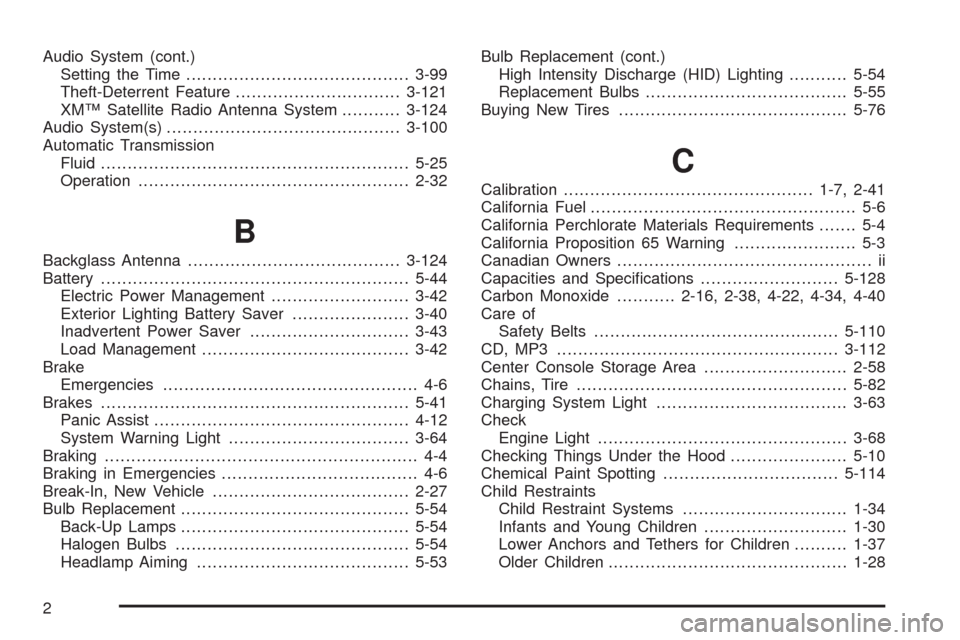
Audio System (cont.)
Setting the Time..........................................3-99
Theft-Deterrent Feature...............................3-121
XM™ Satellite Radio Antenna System...........3-124
Audio System(s)............................................3-100
Automatic Transmission
Fluid..........................................................5-25
Operation...................................................2-32
B
Backglass Antenna........................................3-124
Battery..........................................................5-44
Electric Power Management..........................3-42
Exterior Lighting Battery Saver......................3-40
Inadvertent Power Saver..............................3-43
Load Management.......................................3-42
Brake
Emergencies................................................ 4-6
Brakes..........................................................5-41
Panic Assist................................................4-12
System Warning Light..................................3-64
Braking........................................................... 4-4
Braking in Emergencies..................................... 4-6
Break-In, New Vehicle.....................................2-27
Bulb Replacement...........................................5-54
Back-Up Lamps...........................................5-54
Halogen Bulbs............................................5-54
Headlamp Aiming........................................5-53Bulb Replacement (cont.)
High Intensity Discharge (HID) Lighting...........5-54
Replacement Bulbs......................................5-55
Buying New Tires...........................................5-76
C
Calibration...............................................1-7, 2-41
California Fuel.................................................. 5-6
California Perchlorate Materials Requirements....... 5-4
California Proposition 65 Warning....................... 5-3
Canadian Owners................................................ ii
Capacities and Speci�cations..........................5-128
Carbon Monoxide...........2-16, 2-38, 4-22, 4-34, 4-40
Care of
Safety Belts..............................................5-110
CD, MP3 .....................................................3-112
Center Console Storage Area...........................2-58
Chains, Tire...................................................5-82
Charging System Light....................................3-63
Check
Engine Light...............................................3-68
Checking Things Under the Hood......................5-10
Chemical Paint Spotting.................................5-114
Child Restraints
Child Restraint Systems...............................1-34
Infants and Young Children...........................1-30
Lower Anchors and Tethers for Children..........1-37
Older Children.............................................1-28
2
Page 489 of 500
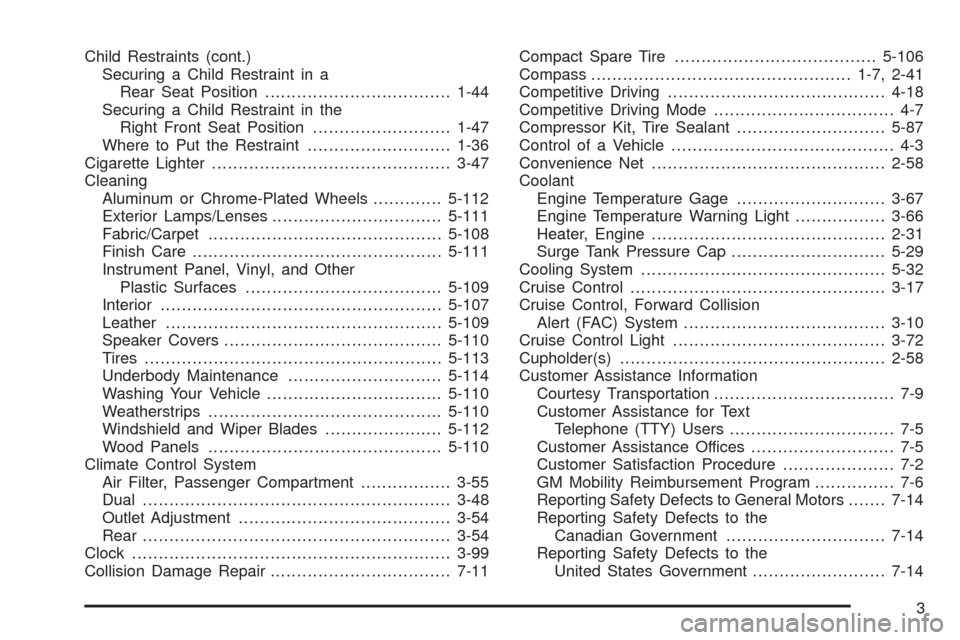
Child Restraints (cont.)
Securing a Child Restraint in a
Rear Seat Position...................................1-44
Securing a Child Restraint in the
Right Front Seat Position..........................1-47
Where to Put the Restraint...........................1-36
Cigarette Lighter.............................................3-47
Cleaning
Aluminum or Chrome-Plated Wheels.............5-112
Exterior Lamps/Lenses................................5-111
Fabric/Carpet............................................5-108
Finish Care...............................................5-111
Instrument Panel, Vinyl, and Other
Plastic Surfaces.....................................5-109
Interior.....................................................5-107
Leather....................................................5-109
Speaker Covers.........................................5-110
Tires........................................................5-113
Underbody Maintenance.............................5-114
Washing Your Vehicle.................................5-110
Weatherstrips............................................5-110
Windshield and Wiper Blades......................5-112
Wood Panels............................................5-110
Climate Control System
Air Filter, Passenger Compartment.................3-55
Dual..........................................................3-48
Outlet Adjustment........................................3-54
Rear..........................................................3-54
Clock............................................................3-99
Collision Damage Repair..................................7-11Compact Spare Tire......................................5-106
Compass.................................................1-7, 2-41
Competitive Driving.........................................4-18
Competitive Driving Mode.................................. 4-7
Compressor Kit, Tire Sealant............................5-87
Control of a Vehicle.......................................... 4-3
Convenience Net............................................2-58
Coolant
Engine Temperature Gage............................3-67
Engine Temperature Warning Light.................3-66
Heater, Engine............................................2-31
Surge Tank Pressure Cap.............................5-29
Cooling System..............................................5-32
Cruise Control................................................3-17
Cruise Control, Forward Collision
Alert (FAC) System......................................3-10
Cruise Control Light........................................3-72
Cupholder(s)..................................................2-58
Customer Assistance Information
Courtesy Transportation.................................. 7-9
Customer Assistance for Text
Telephone (TTY) Users............................... 7-5
Customer Assistance Offices........................... 7-5
Customer Satisfaction Procedure..................... 7-2
GM Mobility Reimbursement Program............... 7-6
Reporting Safety Defects to General Motors.......7-14
Reporting Safety Defects to the
Canadian Government..............................7-14
Reporting Safety Defects to the
United States Government.........................7-14
3
Page 490 of 500
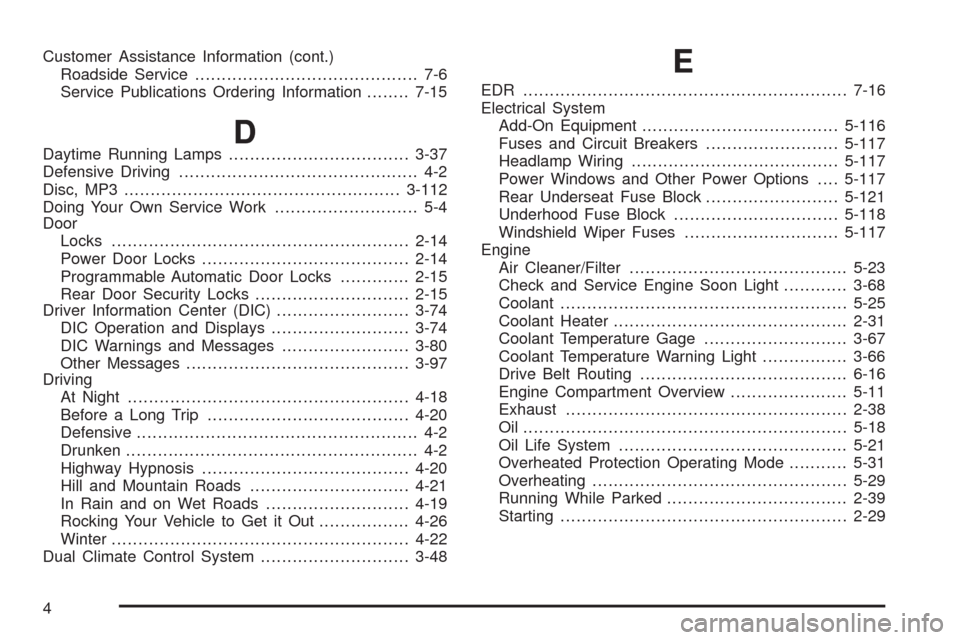
Customer Assistance Information (cont.)
Roadside Service.......................................... 7-6
Service Publications Ordering Information........7-15
DDaytime Running Lamps..................................3-37
Defensive Driving............................................. 4-2
Disc, MP3....................................................3-112
Doing Your Own Service Work........................... 5-4
Door
Locks........................................................2-14
Power Door Locks.......................................2-14
Programmable Automatic Door Locks.............2-15
Rear Door Security Locks.............................2-15
Driver Information Center (DIC).........................3-74
DIC Operation and Displays..........................3-74
DIC Warnings and Messages........................3-80
Other Messages..........................................3-97
Driving
At Night.....................................................4-18
Before a Long Trip......................................4-20
Defensive..................................................... 4-2
Drunken....................................................... 4-2
Highway Hypnosis.......................................4-20
Hill and Mountain Roads..............................4-21
In Rain and on Wet Roads...........................4-19
Rocking Your Vehicle to Get it Out.................4-26
Winter........................................................4-22
Dual Climate Control System............................3-48
E
EDR .............................................................7-16
Electrical System
Add-On Equipment.....................................5-116
Fuses and Circuit Breakers.........................5-117
Headlamp Wiring.......................................5-117
Power Windows and Other Power Options....5-117
Rear Underseat Fuse Block.........................5-121
Underhood Fuse Block...............................5-118
Windshield Wiper Fuses.............................5-117
Engine
Air Cleaner/Filter.........................................5-23
Check and Service Engine Soon Light............3-68
Coolant......................................................5-25
Coolant Heater............................................2-31
Coolant Temperature Gage...........................3-67
Coolant Temperature Warning Light................3-66
Drive Belt Routing.......................................6-16
Engine Compartment Overview......................5-11
Exhaust.....................................................2-38
Oil .............................................................5-18
Oil Life System...........................................5-21
Overheated Protection Operating Mode...........5-31
Overheating................................................5-29
Running While Parked..................................2-39
Starting......................................................2-29
4